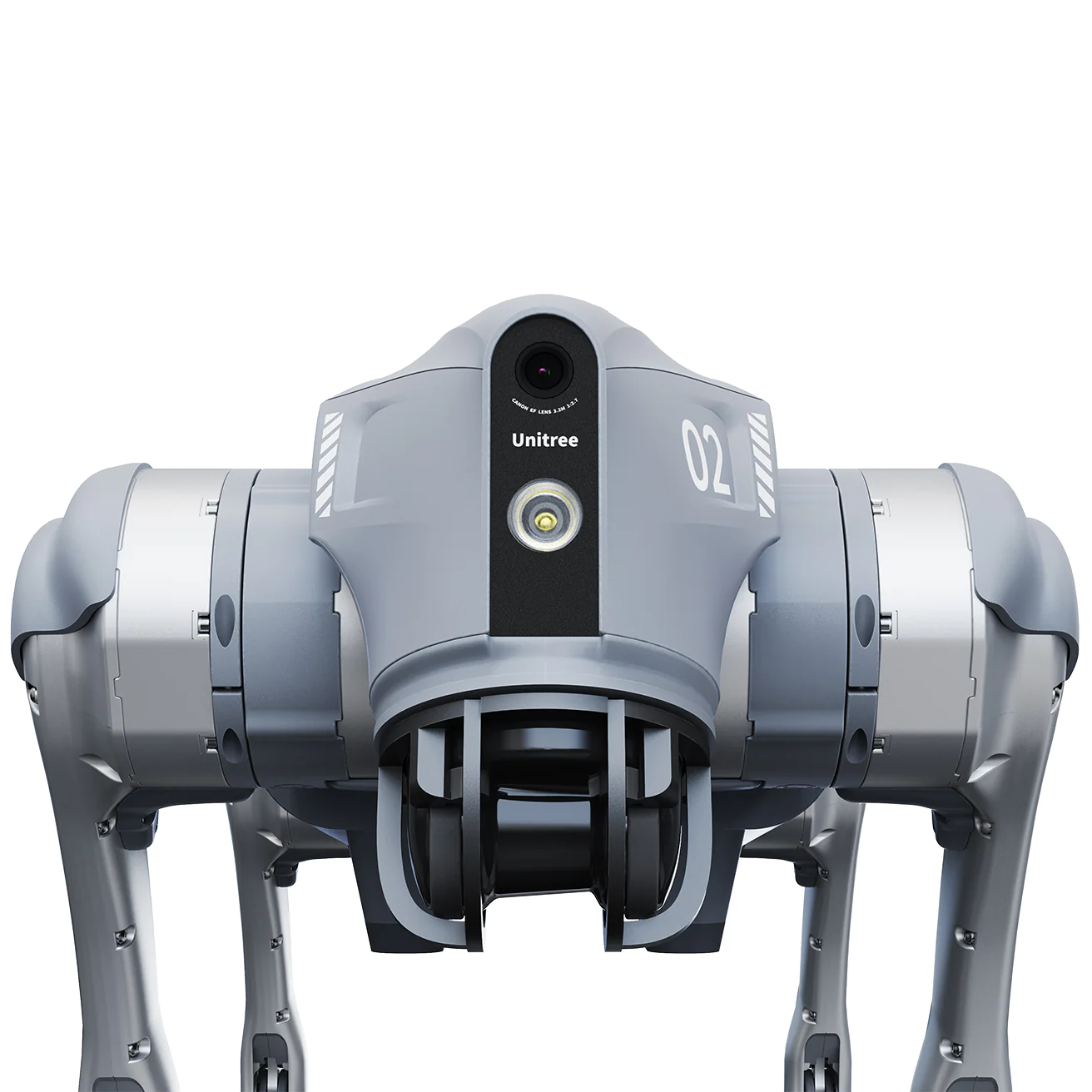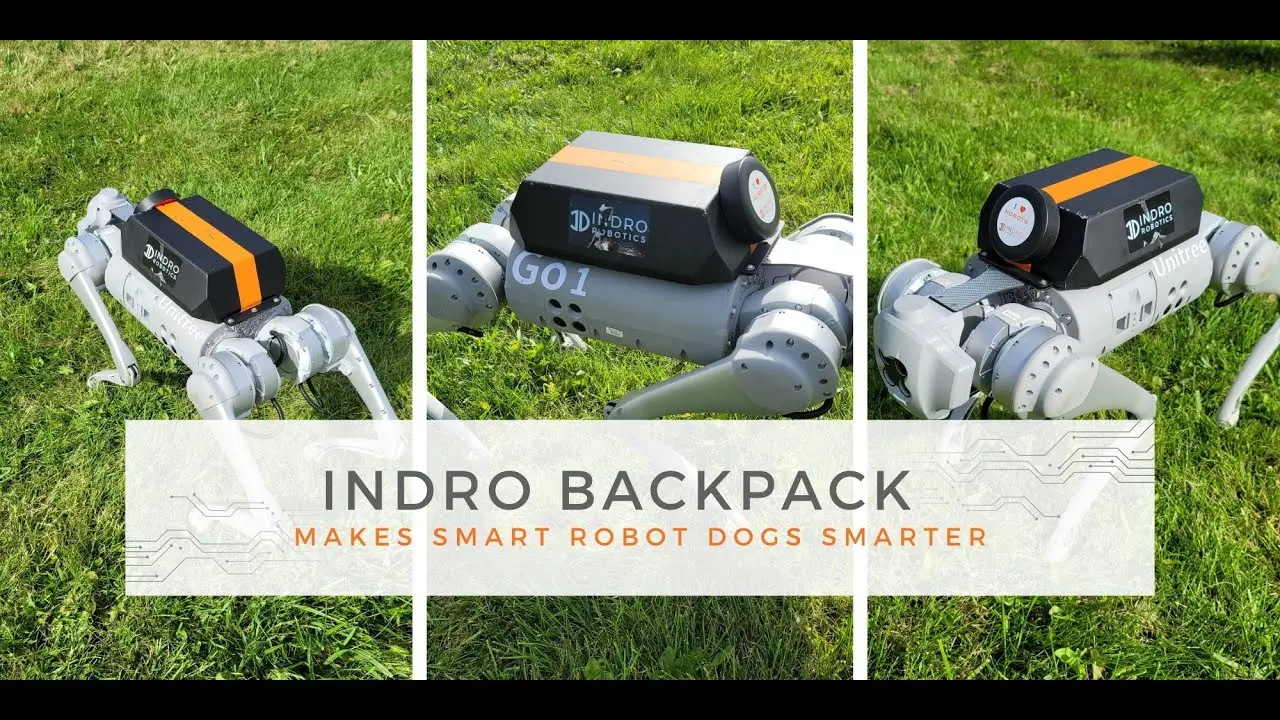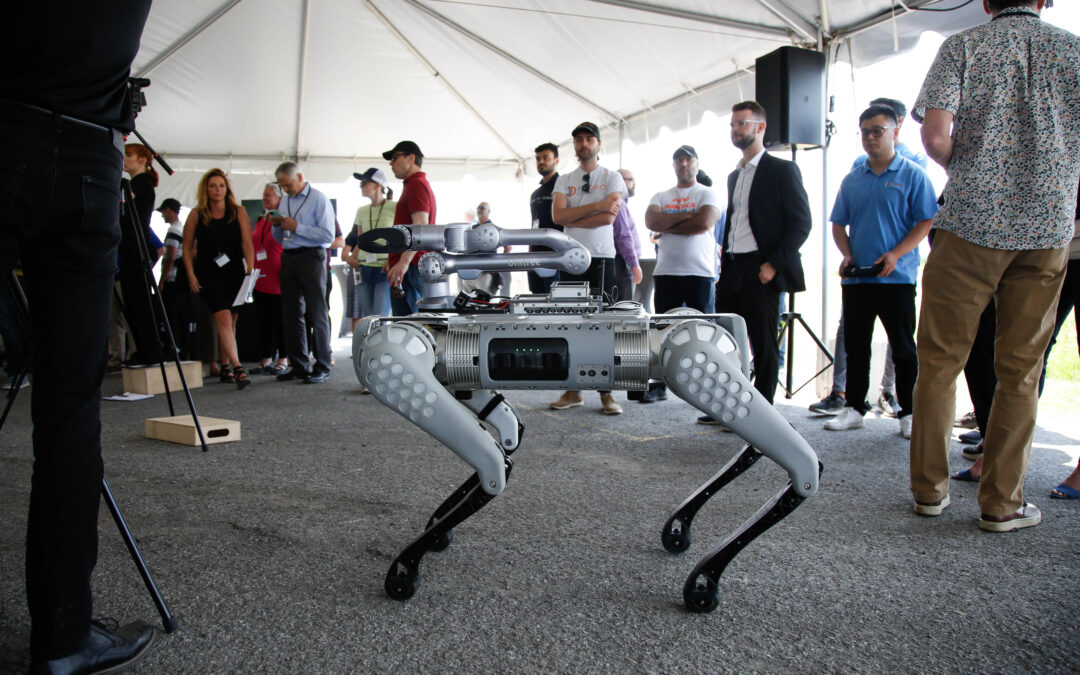By Scott Simmie
If you follow InDro, you’ve likely heard bits and pieces about the Unitree line of robots by now. The Chinese firm specialises in quadruped robots – the ones that always remind people of dogs.
And while some of the Unitree line can indeed pull a few tricks, they’re serious machines. That’s why InDro became a North American distributor of the products. They’ve proven popular with clients, and InDro has done some serious modifications to enhance their capabilities for broader use-cases.
So we thought we’d take a spin through the Unitree line today, with some help from Account Executive Luke Corbeth. He knows these machines inside-out, and is usually the person behind the controls when we’re off at a trade show.
THE COMPANY
Back in 2013, there was no Unitree. But there was a student named Wang Xinxing, who worked hard on building a quadruped as part of his studies at Shanghai University. His vision? To build a powerful quadruped robot powered by low-cost, external brushless motors (think of the dog’s shoulders and hips). Wang took that vision and began working – and working.
He designed and tested legs. Worked on the robot’s control system, including designing motor drive boards, the entire master-slave architecture, the power supply – and much more. At the end of that long and focused process, a working quadruped Wang called XDog (where “X” means “mystery) began walking.
First, XDog was tethered in the lab. But before long, it was out in the wild.
Wang published some of that early R&D on a YouTube channel, which he still maintains. Here’s a look back to XDog in the lab. The description says this video was pulled together in 2014-2015.
PUSHING THE ENVELOPE
That student project – with a lot of further work – would eventually lead to the founding of Unitree in 2016. The firm became one of the first in the world to retail a quadruped. And it continues to put great emphasis on R&D. Here’s a snippet from its website:
“Unitree attaches great importance to independent research and development and technological innovation, fully self-researching key core robot components such as motors, reducers, controllers, LiDAR and high-performance perception and motion control algorithms, integrating the entire robotics industry chain, and reaching global technological leadership in the field of quadruped robots. At present, we have applied for more than 150 domestic patents and granted more than 100 patents, and we are a national high-tech certified enterprise.”
Now, Unitree sells multiple quadrupeds – with more on the way.

GO1 EDU
This affordable robot comes with a lot of capabilites packed in.
Onboard EDGE computing is done by a Jetson Xavier NX. Five sets of fisheye binocular depth-sensing cameras allow the GO1 EDU to see its surroundings from the front, bottom, and sides. AI allows it to detect and classify humans. The robot can also walk alongside a person, rather than the “follow” mode often seen in similar machines.
The GO1 EDU is capable of navigating complex terrain, climbing stairs – even jumping over small obstacles. With a top speed of 14km/hour (3.7m/sec), the long-range GO1 can carry out even extended missions before requiring recharging.
And while the GO1 EDU is capable of carrying out inspection and surveillance work, there are other Unitree products more suited to that use-case. This machine, we’ve found, is best suited to those interested in R&D.
“The EDU version is designed to enable development,” explains Account Executive Luke Corbeth.
“So universities, corporate innovation centres, research institutes – anyone trying to find new ways for quadruped robots to understand their surroundings, plan their motion. Also ways to improve its gait, its ability to move in unpredictable terrain. Those are the sorts of things that are intriguing to this clientele.”
The GO1 has also proven to be appealing for proof-of-concept scenarios.
“Think of real-world applications like construction monitoring, inspections, security,” says Corbeth. “You can do that on a small scale on a budget, prove what you want the ideal workflow to look like, then scale up to one of the larger units.”
In addition to those capabilities, the GO1 EDU also has a playful side. There are a number of pre-programmed moves that make this robot suitable for entertainment applications. It has proven popular on stage with choreographed events and is (as we know) a hit at trade shows.
COMING SOON

GO2
Unitree is set to release the GO2 shortly.
This machine does everything the GO1 EDU can do…and a whole lot more. If you look at the image above, you’ll notice the addition of a new sensor – right in the spot where a traditional dog’s mouth would be. That’s a LiDAR unit, and it significantly enhances the capability of the robot.
The L1 4D LiDAR sensor covers 360° x 90° in real-time. That means the GO2 can scan its surroundings in great detail, allowing for Simultaneous Localization And Mapping (SLAM) as the GO2 moves in its environment. With a mininum detection distance as low as 0.05 metres, no detail will escape the GO2. Equally impressive is the robot’s Generative Pre-trained Transformers (GPT), a neural network that helps GO2 understand and communicate with humans. (And if you’re wondering why they call that LiDAR “4D” – it’s because it can be tilted. So no, it’s not actually capturing in a fourth dimension – but it is versatile.)
The new machine, expected in Q4 2023, is also exceedingly nimble. There are some pretty serious algorithms onboard, and the quadruped is capable of descending stairs on its front two legs alone. Its 8,000mAh battery ensures it’s capable of long-range missions and a 15,000mAh ultra-long life battery is available as an option. The GO2’s voltage was bumped to 28.8V, which means this dog has more power and stability – and can trot along at an impressive 18 kilometres per hour. Software upgrades are carried out wirelessly from a cloud-based network.
“With the addition of the LiDAR unit, the GO2 will appeal to many in the R&D space – particularly those interested in SLAM and autonomous operations,” says Corbeth. “It’s also at a really impressive price point for its capabilities.”
He’s not kidding. Check this out:
THE BIG DOG
Looking for a serious robot for industrial applications? Something with a lot of power, and all-but impervious to even the most extreme weather conditions? Whether it’s remotely monitoring a key outdoor asset or making the rounds of a construction site or sensitive facility, the B1 is more than capable. The 50-kilogram machine is built for business, and can support payloads of up to 100 kilograms. It could easily carry critical supplies on a Search and Rescue mission, in addition to a myriad of sensors. (It can even carry a person on its back, as you’ll soon see.)
The machine is also exceedingly rugged. The B1 has earned an impressive IP68 Ingress Protection rating, meaning it can basically walk underwater – or brave a raging dust storm – with no issues. The robot has been built to withstand punishing conditions that would actually be dangerous for people (just one of the many advantages of robots). LiDAR is available as an option with the B1, allowing for SLAM, Search and Rescue applications, and more.
“This is the model that is most comparable to the Boston Dynamics ‘Spot’ – which is what most people think of when they think quadruped,” says Corbeth. “It also has a higher step height, which makes stairs a lot easier.”
Given its power and flexibility – multiple sensors can be added to the B1 depending on the use-case – this is the machine Corbeth feels is most suited to enterprise/industrial applications.
“This is the one I feel comfortable deploying into the real world at scale over a prolonged period of time. It’s a robust, dependable data collection asset that can be configured to excel at multiple applications.”
And when we said it could go underwater – we weren’t kidding:
SEARCH AND RESCUE
Even S&R applications – along with data acquisition to assist firefighters – are possible with a specially-outfitted B1:
WAIT – THERE’S MORE
The Unitree products are all great on their own. But InDro has developed an add-on that greatly enhances their capabilities. We call it the InDro Backpack, and it significantly improves the capabilities of the GO1 EDU, B1 – and will also be compatible with the GO2 at release.
In a nutshell, the backpack enables:
- Remote teleoperation over 4G or 5G networks
- Simple and intuitive interface for real-time, hands-on control of the robots
- Monitoring of real-time individual sensor output in separate, configurable windows
- Rapid integration of additional sensors without the hassle
We’ve written previously about the InDro Backpack, which is based on our highly popular InDro Commander.
“Out of the box, the Unitree GO1 has an app. But it’s not the greatest at managing all of the camera feeds,” says Corbeth. “Through the ROCOS dashboard, it’s a lot easier to see each of the feeds and get the most out of the impressive hardware that’s in the units. There are five sets of cameras and three sets of ultrasonic sensors – so we can really ensure the client is getting the most out of those.”
The software libraries onboard the Backpack also make any Unitree a fully ROS-enabled robot, which greatly expands their capabilities.
“That’s what makes Backpack valuable to the R&D community,” says Corbeth. “It means clients have access to all available packages to enable a wide range of applications, be it autonomous navigation, perception, motion planning, multi-robot systems – packages to ensure they can really jump-start their project. That’s the InDro value-add.”

NEED A HAND?
Or how ’bout an arm? Here, Unitree has you covered.
The company has developed the Z1, a highly dexterous manipulator. Lightweight but powerful, the Z1 has the option for multiple actuators/end effectors. Whether the task is opening a door or pick-and-place using optical recognition and AI, the Z1 can get it done.
“The world is built for humans and humans have the unique ability to open doors, move levers, press switches. A platform without a manipulator is incapable of interacting with the human world the way that a robot with a manipulator can,” explains Corbeth.
The Z1 can be mounted directly onto the Unitree B1. (We’ve mounted one and have to say it’s pretty impressive.)
“The Z1 is a highly capable manipulator with six degrees of freedom,” says Corbeth. “We are even looking at integrating it with some of the AgileX products we distribute.”
Plus, when compared with other robotic arms with similar capabilities, the Z1 comes in at an attractive price point.
“It’s exceptional value for money. I believe the Z1 will really reduce the barriers to entry – allowing clients to use this hardware to create proof-of-concepts, carry out studies, and just do general research and development with the unit.”
Below: Check out the Z1 in this Unitree video
INDRO’S TAKE
InDro is obviously pleased to be a North American distributor of Unitree products.
But we’re also pretty picky. We wanted to develop a relationship with a company that makes excellent products at a reasonable price, as well as a company that continues to push the envelope. Unitree was a perfect fit.
“If you look at their track record of new product launches and constant improvement and development, they work at a faster clip than anyone else. And that’s also a really good fit with how we do things at InDro,” says Corbeth.
“They’re constantly tweaking things so that their products are perfectly suited for the situations their clients want them to be used in. I’m personally a big fan of these robots – and our own customers have been really pleased, as well.”
You can find more details on the Unitree line – including downloadable spec sheets – right here.
And if you’d like a no-pressure conversation about how a Unitree might fit into your business or research plans, Luke Corbeth would be happy to chat and arrange a demo.

